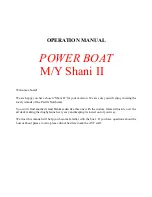
bolt or pin. Trace the forward
side
(luff) of the sail up to the top (head) of
the sail. Insert the luff rope into the
mast slot and hoist about two feet
then secure the Dacron halyard to its
cleat on the side of the mast.
The battens
are now inserted
into
their pockets on the trailing edge or
LEECH of the mainsail. Note that the
battens
are of different
lengths,
as
are the pockets,
so they
must be
matched.
No. the battens aren't too
long' The pocket is tight to keep them
in, so you must push a bit.
Finally, tie the
OUTHAUL LINE
to the
FORWARD
hold of the aft boom end
fitting,
run it through
the clew. Pull
just
hard
enough
to remove
any
wrinkles
in the foot of the sail. and
then tie off. The outhaul line will pre-
vent the foot rope from pulling out of
the SLOT in strong winds.
C. Hoisting The Sails:
The
JIB
is hoisted
first
with
the
halyard tight enough to eliminate any
sag between the snaps BUT NOT SO
TIGHT
that a hard crease appears
radiating upward from the tack. Now
slack off the mainsheet and hoist the
main. Keep the head of the main low
enough so it will not hit the backstay.
Wrinkles
in the MAIN LUFF are re-
moved in the same manner as the jib,
only
the
DOWN
HAUL
LINE,
at-
tached
to
the
bottom
of
the
gooseneck,
does the job.
If you have a topping lift, disengage it
from the boom and secure it to the
mast or backstay.
Keep the sheets
slack as you cast off, give the bow a
hard shove in the direction you want
to go, pull in the jib, so that the wind
pushes the bow in the direction you
are turning,
then
pull in the main
sheet, and ...
YOU'RE SAILING!!!
Section 15.
SAILING TIPS
Now that we have you in the water under
sail, it is undoubtedly
a good time to tell
you how your new sailboat works! This
section was contributed
by Peter Barrett,
a designer of sailboats, and Coastal Rec-
reation,
Inc., and will give you enough
knowledge to start you on your way.
In sailing, the single most important thing
to remember is what direction the wind is
10
blowing. The key to knowing how to set
the sails is the angle between the wind
direction
and the direction
the boat is
pointing.
YOU HAVE
TO KNOW
THE
WIND DIRECTION.
As soon as you get
near the water, determine what direction
the wind is blowing. Look at the waves,
look at the flags, or at smoke. Look at the
direction the boats are pointing while an-
chored or tied by their bow lines. Feel the
breeze
on your
face
and
neck
and
ears-consciously
decide which way the
wind is blowing.
This wind direction will constantly change
by small amounts as the air is deflected
by
houses,
hills,
trees,
etc.
Major
changes
usually
occur gradually,
as a
weather
system
moves through,
or the
land and sea change temperature.
Keep
track of the wind direction. Use tell-tales
(yarns) tied to the side stays.
There are three basic ways a sailboat
can move, related to the wind direction:
One:
It can sail in the same direction
the wind is blowing, being blown along
like a leaf on a pond. This point of sail is
called RUNNING with the wind. The sails
can be on either side of the boat, and the
keel can be pulled
all the way up, as
there is no side force to resist.
RUNNING











































